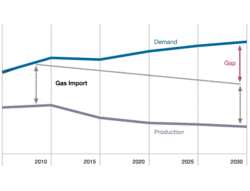Difference between revisions of "Europe's Gas Dependency"
| Line 1: | Line 1: | ||
==Description:== | ==Description:== | ||
The European Union consumes 1,825 million tonnes of oil equivalent (Mtoe) each year to feed its transport and industrial sectors, commerce and private households.<br\> | The European Union consumes 1,825 million tonnes of oil equivalent (Mtoe) each year to feed its transport and industrial sectors, commerce and private households.<br\> | ||
| Line 10: | Line 8: | ||
Add together expected demand growth and the replacement of older power stations with gas-fired ones, and Europe’s total gas demand in 2020 could be 40% higher than it is today. | Add together expected demand growth and the replacement of older power stations with gas-fired ones, and Europe’s total gas demand in 2020 could be 40% higher than it is today. | ||
[[image:Europe_Gas_Demand.gif|thumb| | [[image:Europe_Gas_Demand.gif|thumb|right|250px|Europe Gas Demand]] | ||
==Enablers:== | ==Enablers:== | ||
Revision as of 06:35, 18 September 2009
Description:
The European Union consumes 1,825 million tonnes of oil equivalent (Mtoe) each year to feed its transport and industrial sectors, commerce and private households.<br\> At 37 per cent, oil remains the most intensively used product in the EU's fuel mix, followed by natural gas (24 per cent), solid fuels (18 per cent), nuclear (14 per cent) and renewable sources (7 per cent). Of the approximately 438 Mtoe of gas that are consumed by the EU's 27 countries each year, about 40 per cent comes from member states such as the Netherlands and Britain.<br\> The remaining 60 per cent is imported from four big suppliers: Russia, Norway, Algeria and Nigeria. Of these, Russia is by far the biggest, accounting for 42 per cent of the EU's gas imports, equivalent to about a quarter of its overall yearly needs.<br\> Experts predict that energy consumption is set to increase, with the share of natural gas as the EU's primary energy source likely to surge to 34 per cent in the coming years.<br\> Add together expected demand growth and the replacement of older power stations with gas-fired ones, and Europe’s total gas demand in 2020 could be 40% higher than it is today.
Enablers:
- Alternatives need plenty of money and time, and most are fraught with political difficulties.<br\>
- No political consensus
- Plans by the European Commission to earmark 5 billion euros in unspent EU money on improving energy interconnections between member states have come up against opposition from some member states.
- The EU is also politically split between those who favor closer ties with Russia - such as Germany, France and Italy - and those who treat Moscow with deep suspicion - among them Britain, Sweden, Poland and the Baltics.
- Gazprom insistence that it should be allowed to invest in downstream European energy distribution networks, stoking European fears of even greater reliance on Russian controlled gas.
Inhibitors:
- Building new pipelines from other countries
- Research into alternate sources of energy
- Increasing use of Nuclear energy for electricity
Paradigms:
Europe's dependency on Russia for gas has far reaching consequences. The
Experts:
Timing:
Europe's natural gas needs have been increasing steadily over the last 50 years. However, production within the EU has not increased at the same rate.
Web Resources:
http://www.earthtimes.org/articles/show/250537,background-europes-gas-dependency.html http://www.foreignpolicydigest.org/20080811169/Regional-Archive/Europe/Russia-Archive/the-other-energy-crisis-europes-increasing-dependence-on-russian-natural-gas.html
